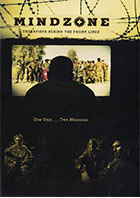
Mind Zone: Therapists Behind the Front Lines 2014
Distributed by J Haaken Productions, LLC, 2250 NW Flanders, Suite 301, Portland, OR 97212; jhaakenproductions@gmail.com
Produced by Ryan Rothmaier; Herzog & Company
Director Jan Haaken
DVD , color, 50 min.
College - General Adult
Post Traumatic Stress Disorder, Soldiers, Afghan War, 2001-
Date Entered: 09/25/2015
Reviewed by Carolyn Walden, Mervyn H. Sterne Library, University of Alabama at Birmingham (Retired)The documentary film Mind Zone describes the work of the 113th Army Combat Stress Control detachment as they train to deploy to Afghanistan as soldiers and therapists. As a combat stress control unit, they will have two missions: prevent post-traumatic stress and return soldiers to duty. They treat combat stress behind the front lines. “Over the next 40 years, medical and disability costs for veterans of Afghanistan and Iraq will range from 600 billion to one trillion dollars.” This closing quote written on the screen summarizes the essence of the rationale for sending therapists behind the front lines. Colonel David Raab, soldier and social worker, leads the detachment as they work both in the battle area and at the Veterans Administration. As described on the container, the film “offers a rarely seen glimpse of heated debates within the field of psychology over the diagnosis and treatment of combat conditions, and the limits of categories such as post-traumatic stress disorder in capturing the psychological impacts of war.”
The comments from the psychological detachment team provide a breadth and depth of information that helps viewers understand the complexity of the challenge of working with stress behind the front lines. Generally combat stress control teams “include providers, who are licensed clinicians, and technicians who receive four to five months of mental health training.” Selected comments from the therapists illustrate that their work makes a difference in bringing soldiers to a “compassionate but quick turnaround” even with all the challenges. Various factual quotations move across the screen at selected times throughout the film sometimes with silence and sometimes with the rhythmic sound of a typewriter that can bring to mind teletype or Morse code. These facts inform, instruct, and allow viewers to enter a small but profound area of the world of soldiers as they work to heal their emotional and psychological wounds that developed from their experiences as soldiers in combat on the front line.
The film includes segments of old films that illustrate the history of training in the army; selected sequences describing the life of a soldier, and descriptions of the resilience training or the 3 day Restoration Center programs. This film complements Healing a Soldier’s Heart and The Welcome: A Healing Journey for War Veterans and their Families. Highly recommended for collections emphasizing post-traumatic stress and mental health services for soldiers and veterans.